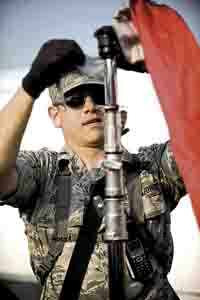INDIANA GUARD HOMELAND EMERGENCY RESPONSE TEAM PUT TO THE TEST
 The Indiana National Guard’s newest addition, a disaster response force package, was put under the microscope on Friday, August 26, 2011 at Camp Atterbury Joint Maneuver Training Center in central Indiana to test and validate their ability.
The Indiana National Guard’s newest addition, a disaster response force package, was put under the microscope on Friday, August 26, 2011 at Camp Atterbury Joint Maneuver Training Center in central Indiana to test and validate their ability.
The 19th CERFP, or Chemical, Biological, Radiological, Nuclear and high-yield Explosive Enhanced Response Force Package, came together at Atterbury for a week of training and validation to certify them as ready for their mission; to come to the aid of the citizens of Indiana in the event of catastrophic disaster whether it be natural or a terrorist attack.
More specifically, in a disaster situation, the CERFP Soldiers and Airmen provide immediate response capability for the citizens of Indiana: incident site search capability of damaged buildings, rescuing trapped casualties, providing decontamination, and performing medical triage and initial treatment to stabilize patients for transport to medical facilities.
“When there’s a catastrophic domestic disaster emergency, the potential for loss of life and medical emergency can be extensive, so the citizens of Indiana really look to the National Guard to play a key role in that response,” said Brig. Gen. Courtney Carr, commanding general of Indiana Guard’s 81st Troop Command. “We’ve got great first responders with great capabilities across the state, but the National Guard is a critical element in that overall response to save lives and eliminate suffering for Hoosiers.”
The unit, headquartered in Indianapolis, is comprised of four major elements; command and control, search and extraction, decontamination, and medical. Each team works autonomously under the command cell.
“This is a joint exercise for both the Army and Air National Guard,” said Brig. Gen. John McGoff, Air Guard chief of staff. “We’ve got 187 Guardsmen out there right now training for some type of a disaster. The Army covers the search and rescue, and the decontamination piece The Air Guard’s role is the medical piece. So after the casualties have been pulled out of the rubble piles and decontaminated, then the Air Guard provides the medical piece of the exercise. This exercise has shown that we can work together very effectively.”
“What I’m seeing here today, I’m certain that this unit will be validated and ready to serve the people of this great state,” said Maj. Gen. R. Martin Umbarger, commanding general of the Indiana National Guard.
“This team will be able to work in a contaminated area, doing search and extraction, getting casualties out, decontaminate the casualties and medically take care of them. That provides a great capability to this state if we were to be hit with a man-made or natural disaster of that type.”
The training arena: the Indiana Department of Homeland Security rubble piles specifically created for training such as this.
The scenario: a 10-kiloton satchel nuclear bomb detonates in a terrorist attack on the citizens of Indiana.
The casualties: role players dressed in tattered clothes and with lifelike wounds staggered around ground zero. Others lay in rubble piles for search and rescue to extract.
A scene played out with a level of realism, lending a sense of urgency to the responders.
“What we want to see is if they’re able to respond to all-hazard incident and do it in a timely fashion,” said Lt. Col. Scott Fuller senior observer controller of the validation process. Fuller is an evaluator with the Joint Interagency Training and Evaluation Center. His team evaluates and trains CERFPs across the nation.
“They have to learn how to decon, triage, search and extraction, and be able to command and control those elements out there in the field.
Based on the Indiana CERFPs performance, Fuller’s team will recommend validation or non-validation to the Indiana Guard commanding general.
After validation, the unit plans to continue growing their knowledge base and training even more.
“We continue to train, we continue to hone our skills,” said Carr. “This validation is really just a minimal acceptable threshold for certification and validation. There’s still additional capability and expertise to be gained, so we’ll continue to train on that and look for opportunities to exercise the CERFP.”
- Community Invited To Paint Rocks For Urban League Project - April 26, 2024
- The “Bad Guys” In Your Garden & What To Do About Them - April 26, 2024
- Why Voting In The Primary Election Matters - April 26, 2024


